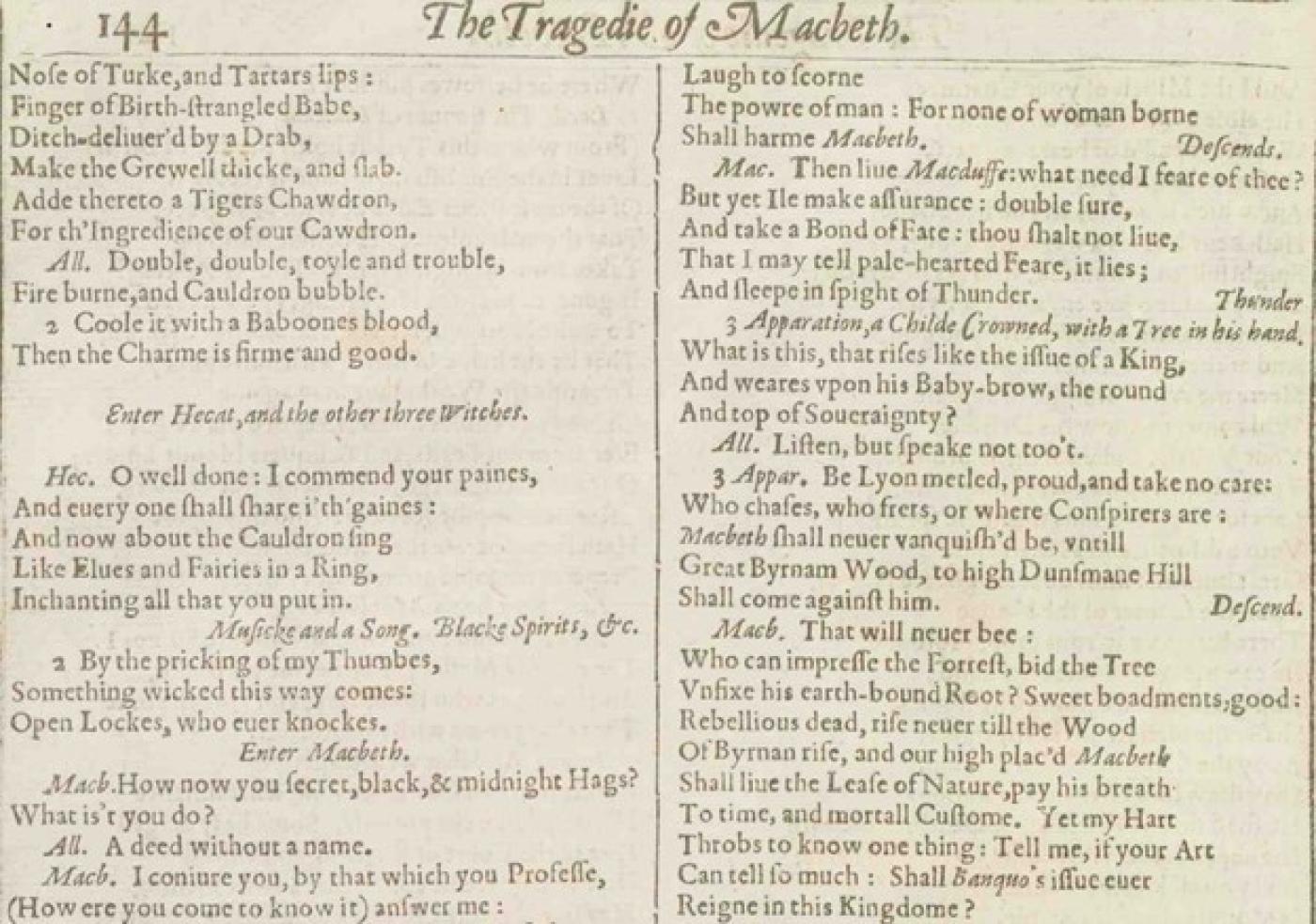Macbeth is one of the eighteen plays that would have been forever lost to us had it not been for the First Folio - which would be a sufficient reason to celebrate the First Folio’s anniversary even if not for the other seventeen plays.
Shakespeare’s career can be roughly divided into four periods: the first, from the late 1580s to the long closure of London’s theaters due to the plague in 1593, consists of the first history tetralogy (the three parts of Henry VI and Richard III) plus Titus Andronicus and several comedies; the second, from roughly 1594-1599, included the second tetralogy (Richard II, the two parts of Henry IV and Henry V) as well as Romeo and Juliet, King John, and several more comedies; the third, taking place in the first few years of the seventeenth century, has a considerably darker tone, perhaps due to the death of his 11-year-old son Hamnet, the anxiety of the final years of Elizabeth’s reign since she was clearly in decline and had no heir, or perhaps simply the desire to write more complex plays about politics and power after the whitewashed jingoism he was obligated to put into his English history cycle - whatever the cause, this period produced Julius Caesar, Hamlet, the so-called “problem comedies”, and was capped off by Othello and King Lear, the transitional works into his final or “Jacobean” period, which clearly begins with Macbeth and also includes Antony and Cleopatra, Coriolanus, and the “romances” including The Winter’s Tale and The Tempest. These later plays are marked by pithier dialogue and a greater reliance on stage effects, and while Shakespeare's plays had always been full of music and dancing, they tended to be tangential to the drama (with notable exceptions like the ball scene in Romeo and Juliet.) We tend to think of Macbeth as a relentlessly dark and lean drama due to its intensity and relative brevity, so you may be surprised to learn that it contains more musical cues than any other Shakespeare play, with frequent "sennets" and "alarums" presumably played by a trumpet accompanied by percussion, as well as several cues for "Hautboys", i.e. shawms or early oboes, which (as I mentioned in an earlier post) were flexible enough to be used for ceremonial music, dance tunes, and, when placed just offstage, creepily evocative sounds of the supernatural.
Which brings us to the witches. There is some controversy surrounding some of their scenes in the First Folio text, which some scholars consider so out of character with the rest of the play that they believe they were added by a non-Shakespearean hand, but no one doubts the authenticity of Act IV, scene 1, the scene in which Macbeth asks the witches for advice (his approach is heralded by one of the witches with the famous line "Something wicked this way comes") and is reassured that his kingship is secure until Birnam Wood comes to Dunsinane. The scene begins with the witches performing what is evidently a solemn ceremony, putting a bunch of disgusting things into a cauldron, and reciting the recipe between chants of the refrain "Double, double, toil and trouble/Fire burn, and cauldron bubble." They are then graced with the presence of the goddess Hecate, who commends their work and leads them in what was evidently an elaborate production number, a song and dance of enchantment. That there is meant to be dancing is evidenced by the line "Like elves and fairies in a ring", and the stage directions are tantalizing but unhelpful: Music and a song: "Black Spirits," etc. The director is left to do their own detective work as to what that means - though in practice what that means is that they just make something up.
Which brings us to Giuseppe Verdi. In his powerful operatic version, this scene occurs at the beginning of Act III. Hecate never appears, and, as Verdi originally wrote it in 1847, Macbeth appears after about five minutes of creepy cauldron-stirring. But when he revised the work in 1865 for a performance in Paris, he was obliged to include a ballet to satisfy the requirements of French opera, and he decided to fulfill this requirement by including a ten-minute dance for the witches between the first and second scenes of Act III. Usually his added ballets for the French audience show the strain of being shoehorned into a plot that doesn't need it, but in this case, the added ballet actually brings us closer to Shakespeare's original conception for the scene, and both the scene itself and the opera as a whole is short enough that the added dance scene doesn't feel like an unnecessary slog. As for the music, it sounds effectively diabolical, with some moments of unexpected tenderness that serve to remind us of the human cost, the innocent victims of these nefarious activities.
As Verdi also demonstrated in his later operas Otello and Falstaff, what he "makes up" in service to Shakespeare is uniquely aligned with his spirit.
PBS PASSPORT
Stream tens of thousands of hours of your PBS and local favorites with WETA+ and PBS Passport whenever and wherever you want. Catch up on a single episode or binge-watch full seasons before they air on TV.
